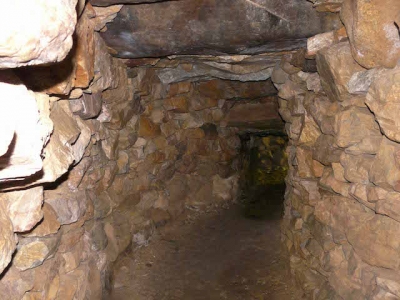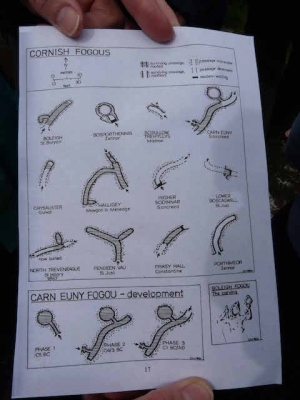 Souterrains, known locally as fogous, form part of the
jetsam of West Cornish prehistory. Prehistory, in Cornwall, runs to the day before yesterday, grandfather’s day, or up to the time when someone started to write it down, but it is generally agreed that the fogou building era was twenty something centuries
ago, in the Iron Age. Agreement as to their use, however, is non-existent, their function only described by bad guesses. Bad guesses include pre-empting the space effort in using up vast amounts of energy & time for largely political motives - perhaps
to lend the settlement cultural prestige in the way a yacht on the lawn might today; or a continuation of the ancient habit of lurking in dark places (prenatal symbiosis, caves for the alive, passage graves for the dead). Ritual is often mentioned; an
appointment with the village shaman might be had in the dark at any time of day - as long as his psychopompic faculties were resonating.
Souterrains, known locally as fogous, form part of the
jetsam of West Cornish prehistory. Prehistory, in Cornwall, runs to the day before yesterday, grandfather’s day, or up to the time when someone started to write it down, but it is generally agreed that the fogou building era was twenty something centuries
ago, in the Iron Age. Agreement as to their use, however, is non-existent, their function only described by bad guesses. Bad guesses include pre-empting the space effort in using up vast amounts of energy & time for largely political motives - perhaps
to lend the settlement cultural prestige in the way a yacht on the lawn might today; or a continuation of the ancient habit of lurking in dark places (prenatal symbiosis, caves for the alive, passage graves for the dead). Ritual is often mentioned; an
appointment with the village shaman might be had in the dark at any time of day - as long as his psychopompic faculties were resonating.
Most were excavated by amateurs, before the days when stratigraphy, carbon dating, electron spin resonance, thermoluminescence and dendrochronology were available to deepen the thrust of the prying professional, and detail of the contemporary content was lost.
We all have theories on mysteries, ranging from the lunatic to the prescient. That fogous have very similar orientation shrieks “astronomical alignment” but their underground situation introduces dark doubt into this equation. Prevailing winds shoulder the stars aside and a mental comparison with the mid Cornwall clay dries, whose hot, gaseous combustion products traverse a long tunnel before venting to the sky, pre-creates the fundamental principle of a grain drier. The massive, flat, horizontal stone slabs roofing the fogous I have seen are adequate support for a few tons of bagged grain – and a theory as mad, or composed, as any other.
 We write history (if we write) on the strength of rumour.
We write history (if we write) on the strength of rumour.
The fogou count of the Meneage is imprecise: rumour tantalises arithmetic, befogging or illuminating the bleary mind's eye; Halliggy is available for inspection on the whimsical departure of the inmates of its bat roost; Boden (¹) is under intensive scrutiny, its hypothesised roof members missing, emigrants now likely masquerading as gateposts - a multi-period site where a Bronze Age individual may have curated a Neolithic artefact long before its fogou was gouged from the earth; a Bronze Age palstave found close to another, now destroyed, suggests the sites had era-long pulling power; yet another contains the bones* of a bull, injured & slaughtered after a rapid entombment, & backfilled to cause future archaeologists head-scratching intrigue before the realisation that the trapped animal was not a cult sacrifice but shot by its owner, the pit filled in yesterday, not the day before.
Psychopomp - conveyer of souls to the afterlife. SciFi indulgents will have seen a portrayal in the Farscape series. West Penwith would be a good place to start the search for one: Siberia has many. Palstave - an early bronze axe. *Bones in Cornwall generally don't last long due to acid soils but, created in serpentine geology, which has a degree of lime mimicry, this fogou could inspire skeletal longmorbidity (a word coined to suggest long-lasting dead structures). Were it backfilled with loess the bull skeleton should be happy as a fly in amber & last nearly as long.
Loess was provided in ample quantities over much of the Lizard peninsula during the most recent ice age, & loiters yet in many places; it has been used as casting sand (²), teams of horses pulling it from Lowland Point to Hayle. The Terracotta Army used a more local Chinese loessic source in the construction of its warriors. Curiously, Lizard potters of antiquity & prehistory chose to use gabbroic clay instead - more of that anon.
(¹) The Evaluation of a Multi-Period Prehistoric Site and Fogou at Boden Vean; Cornish Archaeology Vol 52 (2013); James Gossip.
(²)The Lizard Field Club Vol VI No 2(1978): Lowland Casting Sand Pit: Austyn Pengilly.
Published: Nov 2015
Author: Chris Harris (MAG member)
